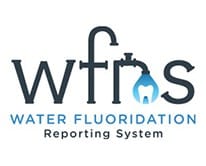At a glance
The Water Fluoridation Reporting System (WFRS) is a data management tool for state water fluoridation program officials. WFRS collects and reports on fluoride levels in public water systems for use by state programs, and it serves as the basis for national reports and analysis.

Overview
The Water Fluoridation Reporting System (WFRS) is an online tool that helps states manage the quality of their water fluoridation programs. WFRS information is also the basis for national surveillance reports that describe the percentage of the U.S. population on community water systems who receive optimally fluoridated drinking water. The system was developed by CDC in partnership with the Association of State and Territorial Dental Directors (ASTDD).
Access the Water Fluoridation Reporting System
What's collected
Water systems that adjust the fluoride of their water to the optimal level for decay prevention also collect data to monitor fluoridation quality. This information includes average fluoride concentrations, results of daily testing, and laboratory split sample results. The dates of facility inspections, operator training, and other relevant information also can be included. State fluoridation managers enter all of these data into WFRS and generate reports that can be used to assure program quality.
Coordination with the U.S. Environmental Protection Agency (EPA)
The WFRS data strategy and structure was modeled on EPA's Safe Drinking Water Information System (SDWIS) to support exchange of data and updates on utility systems. Each water system in the WFRS database includes basic demographic information, including:
- Utility name
- Address
- Population served
- Fluoridation status (e.g., not adjusted, adjusted, natural, variable, or consecutive)
- Natural fluoride concentrations
- Counties and communities served
- System type
- Which systems buy or sell water to other systems
The EPA tracks water systems in its SDWIS database through a unique SDWIS identification number. Using the same identification number for WFRS assures that the information in these two databases can be compared and updated.
Data and public health
The data collected and used in WFRS are provided and owned by the states and tribes. Some states share fluoridation data from WFRS and the fluoridation status of their state via other CDC data applications that have a public access component. Approximately 40 states provide the public with the ability to view the fluoride content of community water systems on CDC's My Water's Fluoride. My Water's Fluoride allows consumers in participating states to learn basic information about their community water system, including the number of people served by the system and the fluoride level.
Consumers also can learn the fluoride content of their water systems by contacting their local water utility service.
